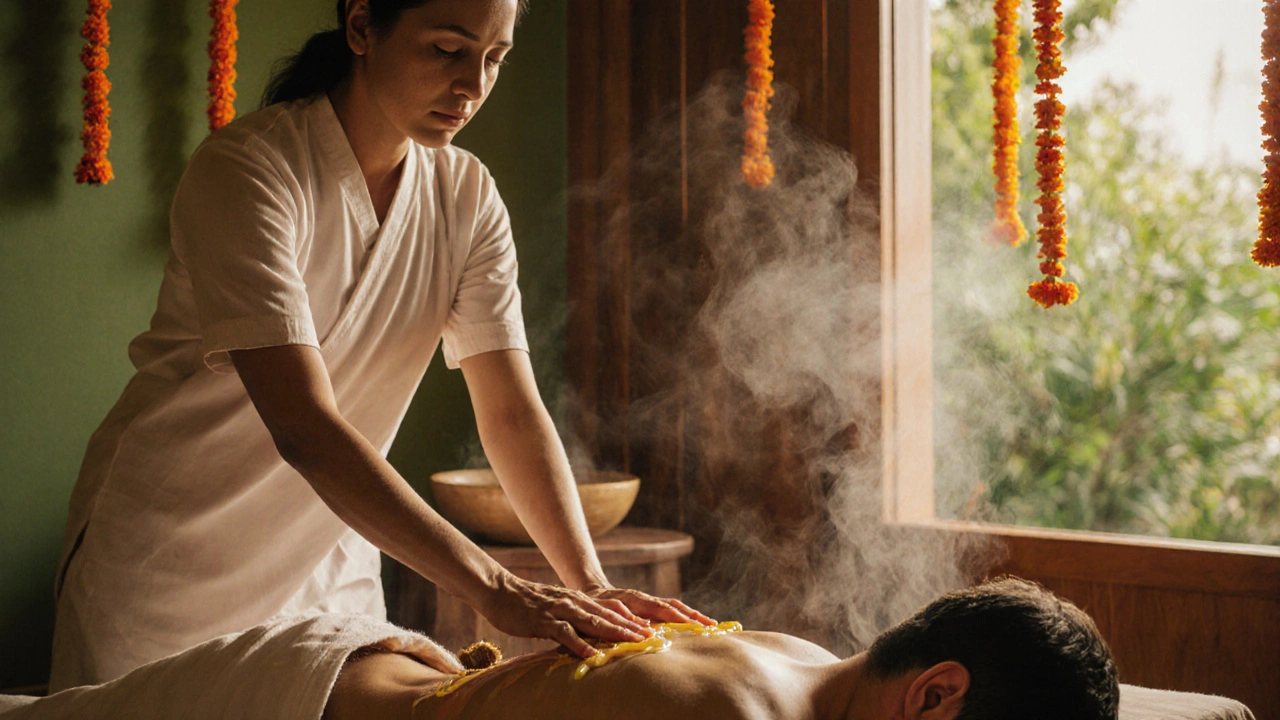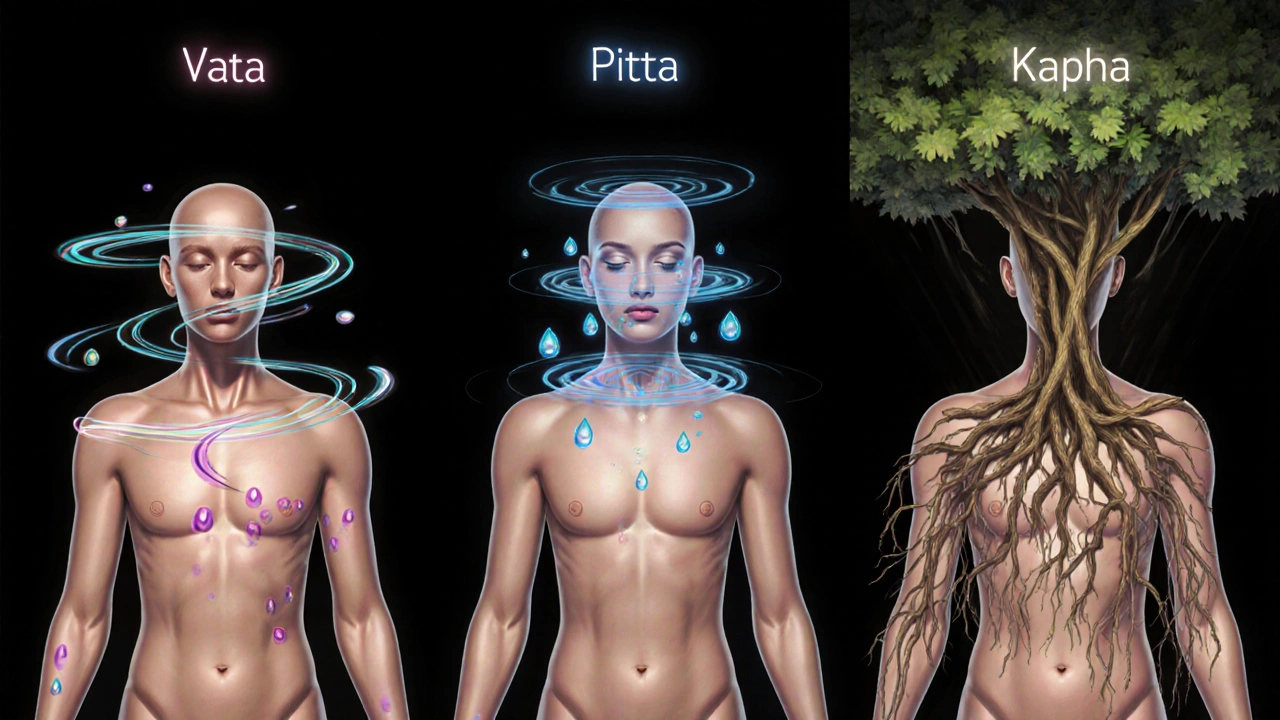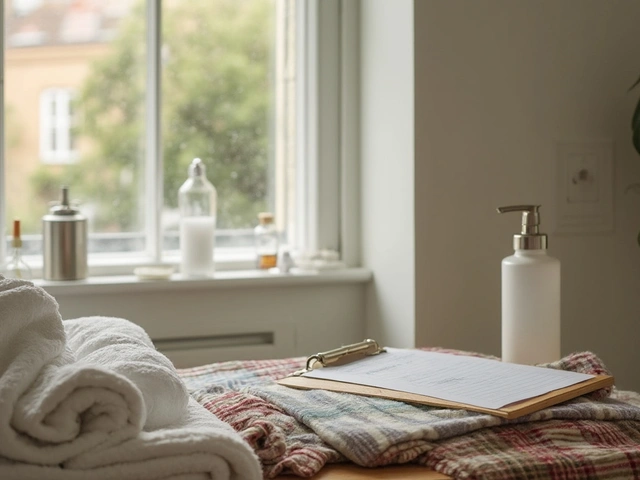Unlocking the Health Benefits of Ayurvedic Massage

Ayurvedic Oil Selection Tool
Find Your Perfect Ayurvedic Oil
Select your dosha to discover the best oil for your body type and benefits. Based on ancient Ayurvedic wisdom.
Determine Your Dosha
Select the option that most closely describes your current physical and emotional state.
Vata Dosha
Dry skin, anxiety, irregular digestion, and sleep issues
Calms nervous energy, moisturizes skin, and helps ground you
Benefits for You
- Reduced anxiety and stress
- Improved sleep quality
- Better digestion and regularity
- Moisturized skin and reduced dryness
How to Use
Warm ¼ cup of oil in a small bowl by placing it in warm water. Apply to your scalp, face, ears, and neck. Use circular motions on the head and gentle strokes down the spine. Massage your arms and legs with long strokes toward the heart. Let the oil sit for 10–15 minutes before showering.
For thousands of years, people in India have used ayurvedic massage not just to relax, but to heal from the inside out. Unlike regular Swedish or deep tissue massage, ayurvedic massage isn’t about loosening tight muscles-it’s about restoring balance to your body’s natural rhythms. If you’ve ever felt drained, stuck, or out of sync, even after a good night’s sleep, ayurvedic massage might be the missing piece you didn’t know you needed.
What Exactly Is Ayurvedic Massage?
Ayurvedic massage, also called abhyanga, comes from Ayurveda, the ancient Indian system of medicine that’s over 5,000 years old. It’s not one technique-it’s a personalized ritual based on your body type, or dosha. There are three doshas: Vata (air and space), Pitta (fire and water), and Kapha (earth and water). Most people have a mix, but one usually dominates.
The massage uses warm herbal oils chosen specifically for your dosha. For Vata types, sesame or almond oil calms nervous energy. Pitta types get cooling coconut or sunflower oil to reduce heat and irritation. Kapha types use lighter, stimulating oils like mustard or grapeseed to wake up sluggish systems. The oil isn’t just a lubricant-it’s medicine in liquid form.
The strokes are slow, rhythmic, and flowing, following the body’s energy channels, called nadis. Practitioners often start at the head and move down to the feet, using long strokes along limbs and circular motions around joints. It’s not about pressure-it’s about penetration. The warmth helps the oils soak into the skin and reach deeper tissues, including the lymph and even the bones.
How It Changes Your Body
After just one session, many people report feeling lighter, calmer, and more grounded. But the real changes happen over time. A 2023 study in the Journal of Ayurveda and Integrative Medicine tracked 120 participants who received weekly ayurvedic massage for eight weeks. Those with high stress levels saw a 34% drop in cortisol, the body’s main stress hormone. Sleep quality improved by 41%, and chronic joint stiffness decreased in 68% of participants.
The massage doesn’t just relax you-it detoxifies. Ayurveda believes toxins, called ama, build up when digestion is weak or stress is high. These toxins clog the system, leading to fatigue, brain fog, and inflammation. The warm oil and rhythmic motion stimulate lymphatic flow, helping the body flush out these built-up wastes. Unlike sauna or sweat-based detoxes, this method works gently, without draining your energy.
It also boosts circulation. Blood moves more freely, bringing oxygen and nutrients to cells. This isn’t just good for muscles-it helps your skin glow, your nails grow stronger, and your hair feel thicker. Many people notice their complexion looks brighter after just a few sessions, not because of makeup, but because their body is finally clearing out what’s been holding it back.
Why It Works Better Than Regular Massage
Most Western massages focus on muscle knots and tension. Ayurvedic massage targets the root cause: imbalance. If your Vata dosha is out of whack, you might feel anxious, have dry skin, and struggle to sleep. A standard massage might make you feel temporarily relaxed, but it won’t fix the underlying issue. Ayurvedic massage does.
It’s also not a one-size-fits-all. A Vata-dominant person gets a slow, grounding massage with heavy oils. A Pitta-dominant person gets a cooler, calming session. Kapha types get a more vigorous, energizing routine. This personalization is why results are deeper and longer-lasting.
Another key difference? Timing. Ayurveda recommends doing abhyanga in the morning, before a shower, when the body’s natural detox systems are most active. Doing it at night can overstimulate some people. The ritual itself-warming the oil, massaging slowly, sitting quietly afterward-is part of the healing. It’s not a quick fix. It’s a daily practice for those serious about wellness.

Real Results from Real People
In Brisbane, where stress levels are high and sleep is often sacrificed, more people are turning to ayurvedic massage. Maria, a 48-year-old teacher, started weekly sessions after years of chronic back pain and insomnia. "I tried physio, acupuncture, even sleep meds. Nothing stuck. After three weeks of ayurvedic massage, I slept through the night for the first time in five years. My pain didn’t vanish, but it stopped controlling me."
Then there’s James, 32, who works in tech. He was always tired, no matter how much coffee he drank. His ayurvedic practitioner told him he had a strong Kapha imbalance-slow digestion, mental fog, low motivation. His routine included daily self-massage with grapeseed oil and a specific breathing exercise. Within six weeks, his energy levels rose. He stopped needing afternoon naps. "I didn’t realize how heavy I felt until it was gone," he said.
These aren’t outliers. They’re examples of what happens when you treat the body as a whole system, not a collection of broken parts.
Can You Do It at Home?
You don’t need a spa or a professional to start reaping benefits. Self-massage, or abhyanga, is a core part of Ayurvedic daily routine. All you need is 10-15 minutes in the morning and a bottle of the right oil.
Here’s how to start:
- Warm ¼ cup of oil in a small bowl by placing it in warm water. Don’t microwave it-heat should be gentle.
- Apply oil to your scalp, face, ears, and neck. Use circular motions on the head and gentle strokes down the spine.
- Massage your arms and legs with long strokes toward the heart. This helps lymph flow.
- Use small circles on joints: shoulders, elbows, wrists, hips, knees, ankles.
- Massage your feet with firm pressure on the soles. This is especially grounding for Vata types.
- Let the oil sit for 10-15 minutes. Then take a warm shower. Don’t scrub hard-let the oil rinse off naturally.
Do this 3-4 times a week. You’ll notice your skin feels softer, your mind quieter, and your body more responsive. It’s not magic. It’s biology meeting tradition.
What to Avoid
Not all oils are right for everyone. Coconut oil is great for Pitta, but it can clog pores and make Vata types feel colder. Mustard oil is powerful for Kapha but can irritate sensitive skin. Always test a small patch first.
Also, don’t rush. If you’re used to fast, intense massages, this might feel too slow. But rushing defeats the purpose. The magic is in the stillness-the quiet moments after the oil sinks in, when your body finally stops fighting and starts healing.
Avoid doing it right after eating. Wait at least two hours after a meal. And if you’re sick, feverish, or have open wounds, skip it. Ayurvedic massage is healing-but not for every condition.

Where to Find a Qualified Practitioner
If you want a professional session, look for someone trained in classical Ayurveda-not just a spa that’s slapped on the word "ayurvedic" to charge more. Ask if they’ve studied under an Ayurvedic college or licensed practitioner. In Australia, look for members of the Australian Ayurvedic Association. They follow strict guidelines on oil selection, dosha assessment, and technique.
A good practitioner will spend time asking about your sleep, digestion, mood, and energy levels before choosing your oil and routine. They won’t just massage you-they’ll help you understand your body’s language.
How Often Should You Do It?
For maintenance, once a week is ideal. If you’re dealing with stress, chronic pain, or poor sleep, aim for twice a week for 4-6 weeks, then scale back. Some people do self-massage daily. That’s fine if it fits your routine. Consistency matters more than intensity.
Seasons matter too. In winter, Vata rises-so oil massages become even more important. In summer, Pitta dominates, so cooler oils and lighter pressure help balance heat. Ayurveda isn’t static. It moves with you.
It’s Not Just a Massage
Ayurvedic massage is one piece of a larger puzzle. It works best when paired with simple habits: eating warm, cooked food; drinking warm water; going to bed before 10 p.m.; and taking five minutes each morning to breathe deeply.
This isn’t about adding more to your to-do list. It’s about replacing noise with stillness. Replacing exhaustion with ease. Replacing reactive health care with preventive wisdom.
For over five millennia, people have trusted this practice-not because it’s trendy, but because it works. You don’t need to believe in Ayurveda to feel its effects. You just need to try it.
Can ayurvedic massage help with anxiety?
Yes. Ayurvedic massage lowers cortisol levels and activates the parasympathetic nervous system, which calms the fight-or-flight response. Studies show regular sessions reduce symptoms of anxiety better than generic relaxation techniques because they’re tailored to your nervous system’s needs. Vata-dominant individuals, who are prone to anxiety, often see the most dramatic improvement.
Is ayurvedic massage safe during pregnancy?
It can be, but only with modifications. Avoid deep pressure, strong oils like mustard or eucalyptus, and massage over the lower abdomen. Warm sesame or coconut oil with gentle strokes on the back, legs, and feet is generally safe after the first trimester. Always consult your midwife or an Ayurvedic practitioner trained in prenatal care.
How long do the effects last?
The immediate relaxation lasts a few hours, but the deeper benefits-better sleep, reduced inflammation, improved digestion-build over time. With weekly sessions, most people report lasting improvements in energy and mood for 4-6 weeks after starting. Consistency turns temporary relief into lasting change.
Do I need to follow an ayurvedic diet too?
Not to see benefits from massage alone, but combining massage with ayurvedic eating habits multiplies results. For example, if you’re Vata and get massage with sesame oil, eating warm, oily, grounding foods like soups and stews helps the body retain the balance. Eating cold salads or raw foods can undo the massage’s effects. It’s not required-but it helps.
Can ayurvedic massage cure chronic pain?
It doesn’t "cure" chronic pain, but it can significantly reduce it by improving circulation, reducing inflammation, and releasing stored tension in connective tissue. Many people with arthritis, fibromyalgia, or lower back pain report less reliance on painkillers after consistent sessions. It’s a tool for management, not a magic fix.
What’s the difference between abhyanga and shirodhara?
Abhyanga is full-body oil massage. Shirodhara is when warm oil is gently poured over the forehead in a steady stream. Shirodhara is deeply calming for the nervous system and is often used for insomnia, anxiety, or headaches. Many practitioners combine both-abhyanga first, then shirodhara for maximum effect.





